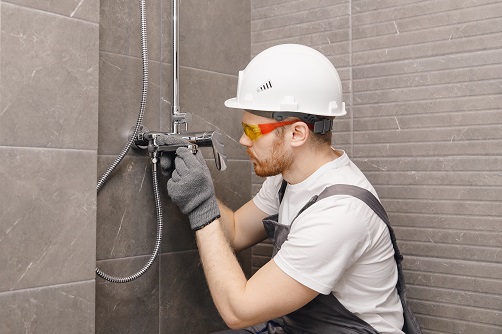You may never know your ceiling has a problem until you look up and see ugly big yellow or brown spots on the ceiling. Unfortunately, the stains are noticeable because many ceilings are white. No matter how beautiful the room is, the brown patches take away all that beauty.
Before you consider painting the brown spots to cover the unpleasant-to-look site, you should first know the cause. If you paint without repairing the damage, the patch will keep reappearing after some months.
You need first to get someone to inspect the roof. If you are tempted to guess what the cause is, please don’t. Although your guess might be correct, sometimes, and most times, you will be repairing the wrong thing.
Professionals like Roof Master will look for any signs of damage on the roof and any other possible reasons your roof is leaking. Although most of your guesses will be about a damaged roof, the reason for the brown spots could be different.
Reasons Your Ceiling Has Brown Spots
Water stains are a significant cause of the brown stains on the roof. Failure of the roof is usually a major reason why this happens, but there could be other reasons for the leak.
Vents and Skylights
Skylights are beautiful ways of allowing natural light into the house through the ceiling. Some people also install their air and plumbing vents at the ceiling to avoid polluting the environment.
These units need professional installation to ensure the part they connect to the roof does not leak. After installation, the installer should use some roofing material around the unit to ensure no leaks or penetrations.
You will know whether the problem is your skylights or vents if the patches are around the units. However, sometimes the patches could be further from the units. Calling a technician to inspect will save you on the guesses.
Heating, Ventilation, and Cooling System
Another cause of yellow or brown patches on ceilings is the HVAC system. Most of these systems are closer to the roof, and just like the vents, poor installation could be a big problem for the ceiling.
Sometimes the system is wet because of condensed air. If there are holes in the HVAC system, the water will drip on the ceiling, causing brown spots. Note that the water is not from the roof but the HVAC.
If your system has a problem, you should call an HVAC contractor to repair it before repainting the ceiling.
Damaged Pipes
When pipes installed in the ceiling walls damage, water will leak, leading to stained ceilings. If you repaint the ceiling without repairing the pipe, you will likely notice the problem again after a month or two.
You should also check your waterproofing membrane on the roof. As the membrane ages, it becomes less reliable and allows water in. Ensure you replace your roofing system to deal with the problem once and for all.
How to Remove Brown Spots on Ceilings and Walls
Besides water damage, moisture causes brown stains on ceilings and walls. This happens when the house is too cold, and there is an accumulation of moisture. The walls’ stain could be due to mold growth.
Brown patches due to moisture are not harmful to your health, but mold can be detrimental, especially to people with allergies. The mold could also spread to other parts of the house, causing damages.
When you notice any stain on the ceiling or walls, it is advisable to take action immediately. After knowing the cause of the spots, repair any damages and repaint the damaged part.
Here are a few steps to help you remove the brown spots on your ceilings and walls.
Step 1: Identify and Repair the Root Cause
The first step is to identify the cause of the problem. For example, if your HVAC system is leaking, you can ask an experienced technician to check the drain pans and air filters for any clogging. If the roof’s shingles are damaged, a roofer can repair those, and the plumber will fix all leaking pipes.
Step 2: Use Bleach and Water
After dealing with the problem, do not hurry to paint the wall or ceiling—mix the bleach in a bucket of water. Wear gloves and cover your eyes. Dip a cloth in the water and place it on the spot.
Put clean water in a spray bottle and spray the area. Next, pass a clean and dry cloth to rinse and dry the area. Removing the stain before painting will remove all the evidence that the wall or ceiling had a stain.
Step 3: Paint
Get the correct paint, and ensure it matches with the one on the rest of the ceiling. Cover the parts of the roof you don’t want the paint to touch. It would be best if you also placed a cloth or covers on the floor to prevent staining.
Paint the ceiling and repeat until the shade matches the other parts and wait for it to dry. You could also use oil and mold-resistant paint to prevent stains in the future.
Step 4: Check for Mold
If the cause of the spots on the ceiling is mold, you should first identify the reasons there is mold in the house. If it’s due to damages to the roof, contact a roofer to repair it.
The major cause of mold in the house is dampness and lack of ventilation. Ensure you keep your windows open. You could also increase the window sizes for better air circulation.
Check if your room has enough lighting. Mold grows in dark areas, and sunshine will discourage its growth. Adding more light in the room will deter mold from growing.
If the stained ceiling is in the kitchen or bathroom, leave the doors and windows in those rooms open. Use water and detergents like hydrogen peroxide, ammonia, baking soda, or tea tree to clean the affected area, then repaint.
Final Words
Seeing damaged parts of your house’s beautiful ceiling can be devastating. You will think of all the possible causes and solutions to the problems. The good news is, you can repair all causes of brown spots on the ceiling and prevent future problems.










